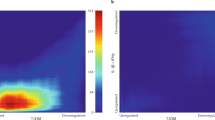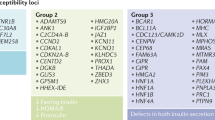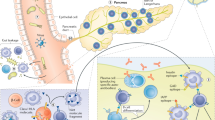Abstract
The pathways that control insulin secretion and regulate pancreatic β-cell mass are crucial in the development of diabetes mellitus. Maturity-onset diabetes of the young comprises a number of single-gene disorders affecting pancreatic β-cell function, and the consequences of mutations in these genes are so serious that diabetes develops in childhood or adolescence. A genetic basis for the more common form of type 2 diabetes, which affects 10–20% of adults in many developed countries, is less clear cut. It is also characterized by abnormal β-cell function, but other tissues are involved as well. However, in both forms identification of causative and susceptibility genes are providing new insight into the control of insulin action and secretion, as well as suggesting new treatments for diabetes.
This is a preview of subscription content, access via your institution
Access options
Subscribe to this journal
Receive 51 print issues and online access
$199.00 per year
only $3.90 per issue
Buy this article
- Purchase on Springer Link
- Instant access to full article PDF
Prices may be subject to local taxes which are calculated during checkout

Similar content being viewed by others
References
American Diabetes Association. Report of the expert committee on the diagnosis and classification of diabetes mellitus. Diabetes Care 24 (Suppl. 1), S5–S20 (2001).
Atkinson, M. A. & Eisenbarth, G. S. Type 1 diabetes: new perspective on disease pathogenesis and treatment. Lancet 358, 221–229 (2001).
Cavaghan, M. K., Ehrmann, D. A. & Polonsky, K. S. Interactions between insulin resistance and insulin secretion in the development of glucose intolerance. J. Clin. Invest. 106, 329–333 (2000).
Kahn, S. E. The importance of β-cell failure in the development and progression of type 2 diabetes. J. Clin. Endocrinol. Metab. 86, 4047–4058 (2001).
Fajans, S. S., Bell, G. I. & Polonsky, K. S. Molecular mechanisms and clinical pathophysiology of maturity-onset diabetes of the young. N. Engl. J. Med. 345, 971–980 (2001).
Owen, K. & Hattersley, A. T. Maturity-onset diabetes of the young: from clinical description to molecular genetic characterization. Best Pract. Res. Clin. Endo. Metab. 15, 309–323 (2001).
Taylor, S. I. & Arioglu, E. Genetically defined forms of diabetes in children. J. Clin. Endocrinol. Metab. 84, 4390–4396 (1999).
Barroso, I. et al. Dominant negative mutations in human PPARγ associated with severe insulin resistance, diabetes mellitus and hypertension. Nature 402, 880–883 (1999).
Polonsky, K. S. & O'Meara, N. M. in Endocrinology 4th edn (eds DeGroot, L. J. & Jameson, L. J.) 697–711 (Saunders, Philadelphia, 2001).
Newgard, C. G. & Matschinsky, F. M. in The Endocrine Pancreas and Regulation of Metabolism (eds Jefferson, L. S. & Cherrington, A. D.) 125–151 (Oxford Univ. Press, Oxford, 2001).
Njølstad, P. R. et al. Neonatal diabetes mellitus due to complete glucokinase deficiency. N. Engl. J. Med. 344, 1588–1592 (2001).
Cereghini, S. Liver-enriched transcription factors and hepatocyte differentiation. FASEB J. 10, 267–282 (1996).
Ryffel, G. U. Mutations in the human genes encoding the transcription factors of the hepatocyte nuclear factor (HNF) 1 and HNF 4 families: functional and pathological consequences. J. Mol. Endocrinol. 27, 11–29 (2001).
Emens, L. A., Landers, D. W. & Moss, L. G. Hepatocyte nuclear factor 1α is expressed in a hamster insulinoma line and transactivates the rat insulin I gene. Proc. Natl Acad. Sci. USA 89, 7300–7304 (1992).
Okita, K. et al. Human insulin gene is a target gene of hepatocyte nuclear factor-1α (HNF-1α) and HNF-1β. Biochem. Biophys. Res. Commun. 263, 566–569 (1999).
Wang, H., Antizozzi, P. A., Hagenfeldt, K. A., Maechler, P. & Wollheim, C. B. Molecular targets of a HNF1α mutation responsible for pancreatic β-cell dysfunction. EMBO J. 19, 4257–4264 (2000).
Wang, H., Maechler, P., Antinozzi, P. A., Hagenfeldt, K. A. & Wollheim, C. B. Hepatocyte nuclear factor 4α regulates the expression of pancreatic β-cell genes implicated in glucose metabolism and nutrient-induced insulin secretion. J. Biol. Chem. 275, 35953–35959 (2000).
Shih, D. Q. et al. Loss of HNF-1α function in mice leads to abnormal expression of genes involved in pancreatic islet development and metabolism. Diabetes 50, 2472–2480 (2001).
Herman, W. H. et al. Diminished insulin and glucagon secretory responses to arginine in nondiabetic subjects with a mutation in the hepatocyte nuclear factor-4α/MODY1 gene. Diabetes 46, 1749–1754 (1997).
Pontoglio, M. et al. Defective insulin secretion in hepatocyte nuclear factor 1α-deficient mice. J. Clin. Invest. 101, 2215–2222 (1998).
Jonsson, J., Carlsson, L., Edlund, T. & Edlund, H. Insulin-promoter-factor 1 is required for pancreas development in mice. Nature 371, 606–609 (1994).
Edlund, H. Transcribing diabetes. Diabetes 47, 1817–1823 (1998).
Stoffers, D. A., Zinkin, N. T., Stanojevic, V., Clarke, W. L. & Habener, J. F. Pancreatic agenesis attributable to a single nucleotide deletion in the human IPF1 gene coding sequence. Nature Genet. 15, 106–110 (1997).
Marshak, S., Totary, H., Cerasi, E. & Melloul, D. Purification of the β-cell glucose-sensitive factor that transactivates the insulin gene differentially in normal and transformed islet cells. Proc. Natl Acad. Sci. USA 93, 15057–15062 (1996).
Stoffers, D. A., Ferrer, J., Clarke, W. L. & Habener, J. F. Early-onset type-II diabetes mellitus (MODY4) linked to IPF1. Nature Genet. 17, 138–139 (1997).
Macfarlane, W. M. et al. Missense mutations in the insulin promoter factor-1 gene predispose to type 2 diabetes. J. Clin. Invest. 104, R33–R39 (1999).
Hani, E. H. et al. Defective mutations in the insulin promoter factor-1 (IPF-1) gene in late-onset type 2 diabetes mellitus. J. Clin. Invest. 104, R41–R48 (1999).
Clocquet, A. R. et al. Impaired insulin secretion and increased insulin sensitivity in familial maturity-onset diabetes of the young 4 (insulin promoter factor 1 gene). Diabetes 49, 1856–1864 (2000).
Chu, K., Nemoz-Gaillard, E. & Tsai, M. J. BETA2 and pancreatic islet development. Recent Prog. Horm. Res. 56, 23–46 (2001).
Malecki, M. T. et al. Mutations in NEUROD1 are associated with the development of type 2 diabetes mellitus. Nature Genet. 23, 323–328 (1999).
Shimomura, H. et al. Nonsense mutation of islet-1 gene (Q310X) found in a type 2 diabetic patient with a strong family history. Diabetes 49, 1597–1600 (2000).
Maassen, J. A. & Kadowaki, T. Maternally inherited diabetes and deafness: a new diabetes subtype. Diabetologia 39, 375–382 (1996).
Velho, G. et al. Clinical phenotypes, insulin secretion, and insulin sensitivity in kindreds with maternally inherited diabetes and deafness due to mitochondrial tRNALeu(UUR) gene mutation. Diabetes 45, 478–487 (1996).
Silva, J. P. et al. Impaired insulin secretion and β-cell loss in tissue-specific knockout mice with mitochondrial diabetes. Nature Genet. 26, 336–340 (2000).
National Institutes of Health. Diabetes in America 2nd edn. NIH Publication No. 95–1468 (1995).
Ludwig, D. S. & Ebbeling, C. B. Type 2 diabetes mellitus in children. J. Am. Med. Assoc. 268, 1427–1430 (2001).
Pick, A. et al. Role of apoptosis in failure of β-cell mass compensation for insulin resistance and β-cell defects in the male Zucker diabetic fatty rat. Diabetes 47, 358–364 (1998).
Milburn, J. L. Jr et al. Pancreatic β-cells in obesity. Evidence for induction of functional, morphological, and metabolic abnormalities by increased long chain fatty acids. J. Biol. Chem. 270, 1295–1299 (1995).
Cockburn, B. N. et al. Changes in pancreatic islet glucokinase and hexokinase activities with increasing age, obesity and the onset of diabetes. Diabetes 46, 1434–1439 (1997).
García-Ocaña, A. et al. Using β-cell growth factors to enhance human pancreatic islet transplantation. J. Clin. Endocrinol. Metab. 86, 984–988 (2001).
Flier, S. N., Kulkarni, R. N. & Kahn, C. R. Evidence for a circulating islet growth factor in insulin-resistant states. Proc. Natl Acad. Sci. USA 98, 7475–7480 (2001).
Tuttle, R. L. et al. Regulation of pancreatic β-cell growth and survival by the serine/threonine protein kinase Akt/PKBα. Nature Med. 7, 1133–1137 (2001).
Zhang, C. Y. et al. Uncoupling protein-2 negatively regulates insulin secretion and is a major link between obesity, β cell dysfunction, and type 2 diabetes. Cell 105, 745–755 (2001).
Carpentier, A., Mittelman, S. D., Bergman, R. N., Giacca, A. & Lewis, G. F. Prolonged elevation of plasma free fatty acids impairs pancreatic β-cell function in obese nondiabetic human but not in individuals with type 2 diabetes. Diabetes 49, 399–408 (2000).
Altshuler, D. et al. The common PPARγ Pro12Ala polymorphism is associated with decreased risk of type 2 diabetes. Nature Genet. 26, 76–80 (2000).
Luan, J. et al. Evidence for gene-nutrient interaction at the PPARγ locus. Diabetes 50, 686–689 (2001).
Stefan, N., Fritsche, A., Häring, H. & Stumvoll, M. Effect of experimental elevation of free fatty acids on insulin secretion and insulin sensitivity in healthy carriers of the Pro12Ala polymorphism of the peroxisome proliferator-activated receptor-γ2 gene. Diabetes 50, 1143–1148 (2001).
Olefsky, J. M. Treatment of insulin resistance with peroxisome proliferator-activated receptor γ agonists. J. Clin. Invest. 106, 467–472 (2000).
Cavaghan, M. K., Ehrmann, D. A., Byrne, M. M. & Polonsky, K. S. Treatment with the oral antidiabetic agent troglitazone improves β cell responses to glucose in subjects with impaired glucose tolerance. J. Clin. Invest. 100, 530–537 (1997).
Dubois, M. et al. Expression of the peroxisome proliferator-activated receptor γ (PPARγ) in normal human pancreatic islets. Diabetologia 43, 1165–1169 (2000).
Kulkarni, R. N. et al. Tissue-specific knockout of the insulin receptor in pancreatic β cells creates an insulin secretory defect similar to that in type 2 diabetes. Cell 96, 329–339 (1999).
Leibiger, B. et al. Selective insulin signaling through A and B insulin receptors regulates transcription of the insulin and glucokinase genes in pancreatic β cells. Molecular Cell 7, 559–570 (2001).
Horikawa, Y. et al. Genetic variation in the gene encoding calpain-10 is associated with type 2 diabetes mellitus. Nature Genet. 26, 163–175 (2000).
Baier, L. J. et al. A calpain-10 gene polymorphism is associated with reduced muscle mRNA levels and insulin resistance. J. Clin. Invest. 106, R69–R73 (2000).
Sreenan, S. K. et al. Calpains play a role in insulin secretion and action. Diabetes 50, 2013–2020 (2001).
Wiltshire, S. et al. A genomewide scan for loci predisposing to type 2 diabetes in a U.K. population (the Diabetes UK Warren 2 Repository): analysis of 573 pedigrees provides independent replication of a susceptibility locus on chromosome 1q. Am. J. Hum. Genet. 69, 553–569 (2001).
National Center for Biotechnology Information. 〈http://www.ncbi.nlm.nih.gov/〉 (2001).
Moore, A., Bonner-Weir, S. & Weissleder, R. Noninvasive in vivo measurement of β-cell mass in mouse model of diabetes. Diabetes 50, 2231–2236 (2001).
Seino, S., Iwanaga, T., Nagashima, K. & Miki, T. Diverse roles of KATP channels learned from Kir6.2 genetically engineered mice. Diabetes 49, 311–318 (2000).
Acknowledgements
We thank the members of our laboratories for their contributions to the studies presented here. This work was supported by grants from the NIH and a gift from the Blum-Kovler Foundation. G.I.B. is an investigator of the Howard Hughes Medical Institute.
Author information
Authors and Affiliations
Rights and permissions
About this article
Cite this article
Bell, G., Polonsky, K. Diabetes mellitus and genetically programmed defects in β-cell function. Nature 414, 788–791 (2001). https://doi.org/10.1038/414788a
Issue Date:
DOI: https://doi.org/10.1038/414788a
This article is cited by
-
Upregulation of GLUT4 Expression and Glucose Homeostasis by Synthetic Peptides HL-7 and HL-10 in in-vitro and in-vivo Diabetic Models
International Journal of Peptide Research and Therapeutics (2023)
-
Mutated lncRNA increase the risk of type 2 diabetes by promoting β cell dysfunction and insulin resistance
Cell Death & Disease (2022)
-
Genetic variation in DPP-IV gene linked to predisposition of T2DM: A case control study
Journal of Diabetes & Metabolic Disorders (2022)
-
Multi-ethnic GWAS and fine-mapping of glycaemic traits identify novel loci in the PAGE Study
Diabetologia (2022)
-
On the causal relationships between hyperinsulinaemia, insulin resistance, obesity and dysglycaemia in type 2 diabetes
Diabetologia (2021)
Comments
By submitting a comment you agree to abide by our Terms and Community Guidelines. If you find something abusive or that does not comply with our terms or guidelines please flag it as inappropriate.



